-

Win a Free Custom Engraved Brass Coin!!!
As a way to introduce our brass coins to the community, we will raffle off a free coin during the month of August. Follow link ABOVE for instructions for entering.
-

PRE-ORDER SHIPS IN SCALE TODAY!
The beloved Ships in Scale Magazine is back and charting a new course for 2026!
Discover new skills, new techniques, and new inspirations in every issue.
NOTE THAT OUR FIRST ISSUE WILL BE JAN/FEB 2026
You are using an out of date browser. It may not display this or other websites correctly.
You should upgrade or use an alternative browser.
You should upgrade or use an alternative browser.
ZEEHAEN 1639, 1:37.5, Dutch fluit from Dutch Explorer Abel J. Tasman by Marcus
- Thread starter flying_dutchman2
- Start date
- Watchers 16
-
- Tags
- dutch fluit zeehaen
- Joined
- Mar 11, 2020
- Messages
- 213
- Points
- 143

Not much rain in this area of the US. In the 90's and 100's.
Global warming is upon my neck of the woods. Less rain in the spring and warmer winters.
Drip irrigation throughout the garden. I have a well for the water so no city ordnance telling me I can't water or water every other day or something like that.
My lawn is already going dormant due to the drought. I don't care about grass. Unlike me neighbors who love their lawn and have sprinklers on daily. There shrubs die or become severely stunted. What they don't understand is that lawn grass will come out of dormancy when there is rain and cooler weather but there shrubs, perennial plants and trees die. No dormant weather to come out of this, just expensive replacements.
Marcus
Global warming is upon my neck of the woods. Less rain in the spring and warmer winters.
Drip irrigation throughout the garden. I have a well for the water so no city ordnance telling me I can't water or water every other day or something like that.
My lawn is already going dormant due to the drought. I don't care about grass. Unlike me neighbors who love their lawn and have sprinklers on daily. There shrubs die or become severely stunted. What they don't understand is that lawn grass will come out of dormancy when there is rain and cooler weather but there shrubs, perennial plants and trees die. No dormant weather to come out of this, just expensive replacements.
Marcus
- Joined
- Mar 11, 2020
- Messages
- 213
- Points
- 143

Thanks for all the likes, suggestions and comments.
Today till Saturday on and off rain so no garden work. We get much needed rain whereas the South and the East of the US are floating away as they have too much rain.
Actively working on deck items.
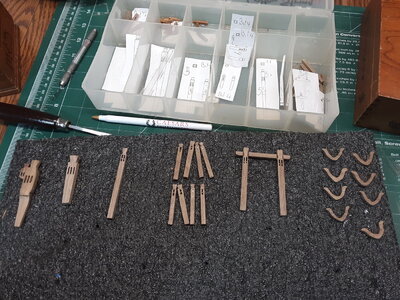
Different types of bits.
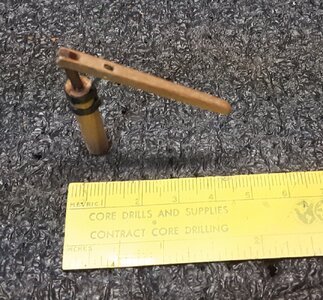 Pump
Pump
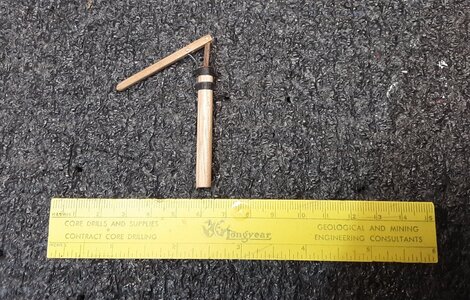
Pump
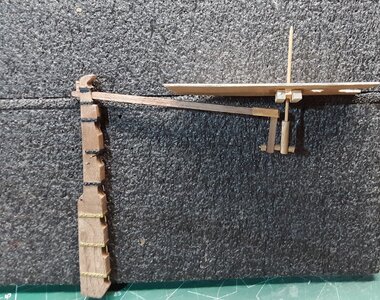
Whipstaff and how it is installed under the deck.
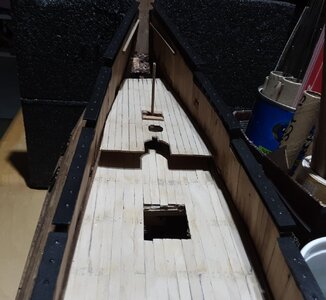
Whipstaff
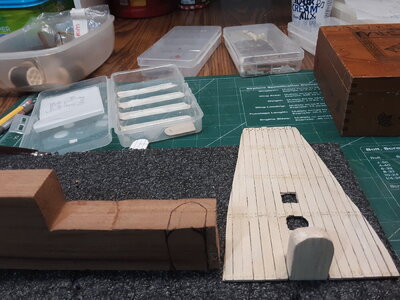
This door is first cut out of balsa and sanded to specs. On the left a block of cherry with the outline of the door.
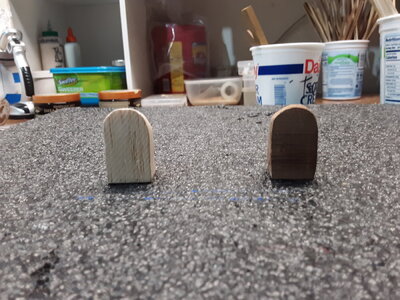
Balsa door template on the left, final cherry door on the right.
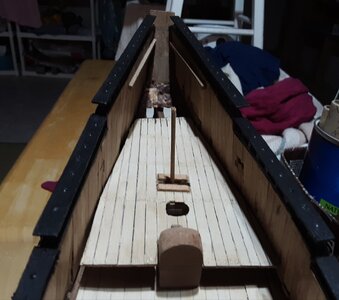
Location of the door.
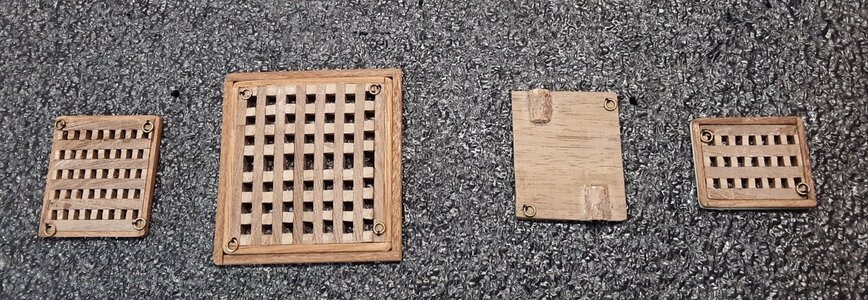
Gratings made out of cherry and walnut.
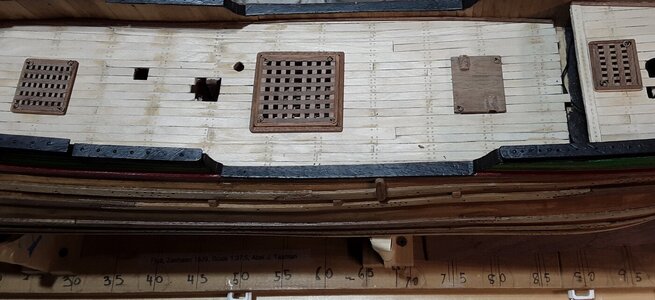
Gratings installed on the decks.
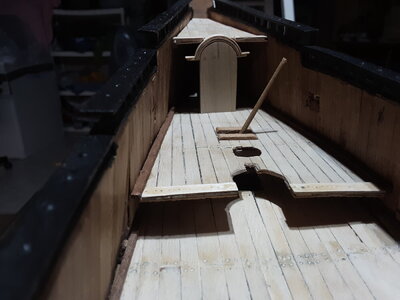
Door from the captain's quarters.
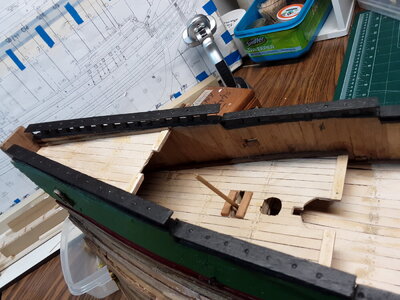
Different layers of decks.
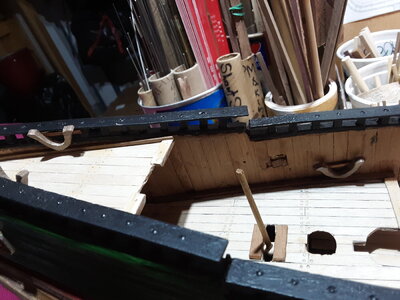
Different installed bits
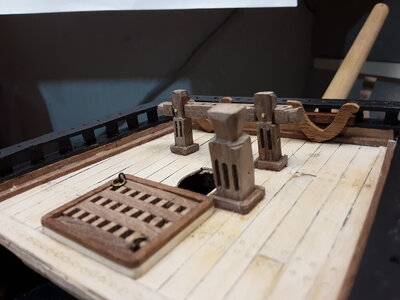 Bits
Bits
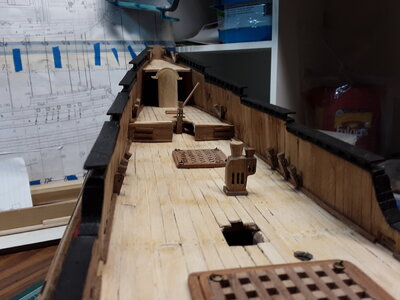
Deck items in place.
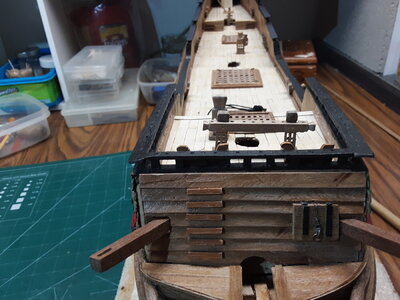
Fluit Zeehaen all decks
Marcus
Today till Saturday on and off rain so no garden work. We get much needed rain whereas the South and the East of the US are floating away as they have too much rain.
Actively working on deck items.

Different types of bits.
 Pump
Pump
Pump

Whipstaff and how it is installed under the deck.

Whipstaff

This door is first cut out of balsa and sanded to specs. On the left a block of cherry with the outline of the door.

Balsa door template on the left, final cherry door on the right.

Location of the door.

Gratings made out of cherry and walnut.

Gratings installed on the decks.

Door from the captain's quarters.

Different layers of decks.

Different installed bits
 Bits
Bits
Deck items in place.

Fluit Zeehaen all decks
Marcus
Hallo @flying_dutchman2The Zeehaen, a Dutch fluit used by the Dutch explorer Abel Tasman. But first some historical background information of a Fluit.
Shipbuilders, skippers and other curious people, from near and from far, travelled to Hoorn in Noord Holland to look at the new ship. A prominent merchant, Pieter Janszoon Liorne, had turned his view of the ideal merchant vessel into reality. By the end of the sixteenth century there existed a ship type called a fluit, which had some specific characteristics.
Seen from the side a fluit looks just like any old three-masted sailing ship. The mainmast and the foremast have square sails and the aftermost mizzenmast has a triangular lateen-sail occasionally supplemented with some smaller sails on the bowsprit and mizzenmast.
The particularities of the fluit’s hull become apparent when seen from above or from astern. From above the outline of the hull appears as a rectangle box with slightly rounded corners. Seen in cross section the sides of the hull slope inwards, so-called ‘tumble-home’, which result in very narrow upper works. The rounded lower parts of the stern are crowned by a narrow flat transom, giving it a pronounced pear-shape. It might be that this shape, which stern-on gave the impression that the after works looked something like a thinly shaped glass, a flute, is the origin of the name.
The Dutch fluit was a classic merchant ship of the 17th century. It was built to be economical in operation, carrying the largest cargo and smallest crew possible. The rigging was designed to be sailed and operated with proportionally small crews (12 to 13) , and its narrow upper deck was designed to evade Danish customs dues when passing through the sound in to the Baltic, where duties were levied according to the size of the breadth of the deck.
There are several reasons for building a hull of this shape. Keeping the center of gravity low is perhaps the most obvious. The idea that the hull shape of the fluit was adjusted to cut costs probably derives from the general reputation of the Dutch merchants at the time. Creating a ship type that kept costs to a minimum becomes just another way to confirm their superiority and skill when it came to making profit.
The fluit was a total success. From the end of the 16th century to the mid 18th century fluits were amongst the most common type of merchant vessels in Northern Europe and the Baltic Sea. In the Dutch Golden Age, 80% of the ocean going vessels were fluits and were built at an average of 400 to 500 annually. They were easy and cheap to build thanks to standardization of design as well as a technological improvements, such as the sawmill, which was invented by the Dutch.
The fluit was a ‘multi-purpose’ vessel, a ship that with slight adjustments could meet a wide range of demands. Even if the term embraces a range of ships which share some important characteristics, there are variations with important differences. The size of fluits varied considerably. The smallest versions, sometimes referred to as the boot, were 86 feet at most (around 24m), whereas the largest versions were 140 feet (just over 39 m) and larger. Variations of the basic concept did not only affect the size, but included some special features connected to the trades in which these ships were used.
Noortsvaarders or Houthaalders - Woodhauler was developed with ports in the bow and stern for loading long beams and timbers, They were of about 300-350 tons, with simple hulls and an armament of small guns.
Ostervaarders, especially designed for the shallow harbours of the Baltic Sea.
Fransvaerders, Spaensvaerders and the Straetsvaerders, so called because they were used in the trade with France, Portugal or Spain and the Mediterranean (through the straits). From the exterior, they differed from the other varieties through the beakhead
The Vereenigde Oost-Indische Compagnie, VOC, (United East India Company), employed a number of fluits.
Fluits were also used as whalers which are easy to distinguish in depictions as they have davits on the sides for lifting whaling boats.
Next, a biography about Abel Tasman
we wish you all the BEST and a HAPPY BIRTHDAY

- Joined
- Mar 11, 2020
- Messages
- 213
- Points
- 143

Thank you.
Marcus
Happy Birthday, Marcus! 

- Joined
- Mar 11, 2020
- Messages
- 213
- Points
- 143

Thank youHappy Birthday, Marcus!
Bedankt.Fijne verjaardag Marcus.
Thank you Heinrich, it made me smile, especially the gardening. So far it has been a bumper crop year.Happy Birthday Marcus. May you have many more and may the year ahead be full of health, gardening and model building!
Marcus
- Joined
- Mar 11, 2020
- Messages
- 213
- Points
- 143

Thanks for all the likes, suggestions and comments.
Now that there is less work in the garden I am continuing work on the Zeehaen and working on the windlass. After the 1st try, which went in the wood box the second attempt is much better. I use walnut as I have a lot of that and I like working with that wood.
This will be an 8 sided windlass. After I pm'd Ab Hoving on this he msgd., me that the Dutch in the 17th century used either a 6 or an 8 sided windlass. It all depended on how large the ship was and how much power you needed to haul material.
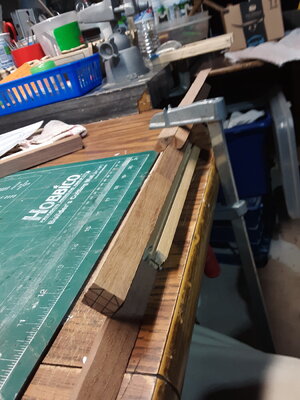
I have a jig to plane 4 sides to a 45 degree angle.
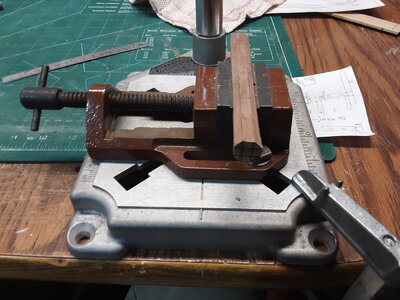
Small vice bolted to a dremel stand clamped to a table.
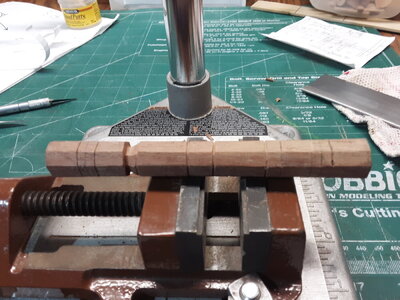
Mark distance with pencil and use a carving knife and Xacto blade to slowly shave of areas. The outer sides are lower than the inner ones.
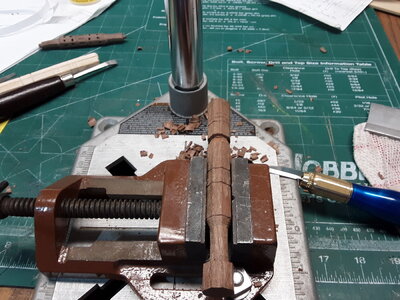
Next side.
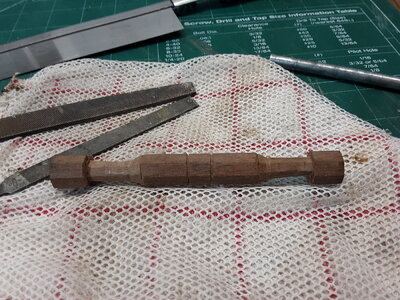
The end pieces will be cut off.
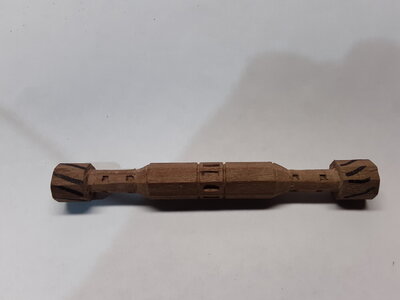
The square holes are made and still needs to be sanded.
Marcus
Now that there is less work in the garden I am continuing work on the Zeehaen and working on the windlass. After the 1st try, which went in the wood box the second attempt is much better. I use walnut as I have a lot of that and I like working with that wood.
This will be an 8 sided windlass. After I pm'd Ab Hoving on this he msgd., me that the Dutch in the 17th century used either a 6 or an 8 sided windlass. It all depended on how large the ship was and how much power you needed to haul material.

I have a jig to plane 4 sides to a 45 degree angle.

Small vice bolted to a dremel stand clamped to a table.

Mark distance with pencil and use a carving knife and Xacto blade to slowly shave of areas. The outer sides are lower than the inner ones.

Next side.

The end pieces will be cut off.

The square holes are made and still needs to be sanded.
Marcus
- Joined
- Jan 9, 2020
- Messages
- 10,543
- Points
- 938

Looking good Marcus! It is great to see you back on the Zeehaen. Have you seen @Kolderstok Hans's amazing Fluyt that is under development?
Easiest way to make octagonal stock: use a low angle block plane. Easy peasy!
Sorry for the Offtop, Markus.Easiest way to make octagonal stock: use a low angle block plane. Easy peasy!
low angle plane is the tool (cost about $100.00~150.00), but what are the techniques? Just remove wood from the sides? Also. why a bench plane or adjustable Mouth Block Plane will not work?
Thank you!
You could use a jointer plane if you wanted. Just thinking the easiest way to manage in your hand and appropriate for the scale of the stock shown in the post.Sorry for the Offtop, Markus.
low angle plane is the tool (cost about $100.00~150.00), but what are the techniques? Just remove wood from the sides? Also. why a bench plane or adjustable Mouth Block Plane will not work?
Thank you!
Last edited:
- Joined
- Mar 11, 2020
- Messages
- 213
- Points
- 143

I use a small planer from Stanley, a homemade draw knife and various sharp knives.
Marcus
Marcus
- Joined
- Mar 11, 2020
- Messages
- 213
- Points
- 143

Thanks for all the likes, suggestions and comments.
After sanding the windlass barrel, added the ratchet teeth for the pawl bit. Painted the holes matt black. Added the supporting posts on each side and installed the complete piece on the upper deck. Added the anchor rope and put the excess into the holes of the hatch cover.
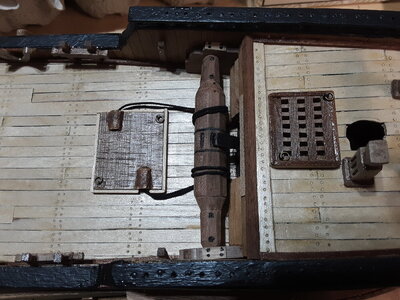
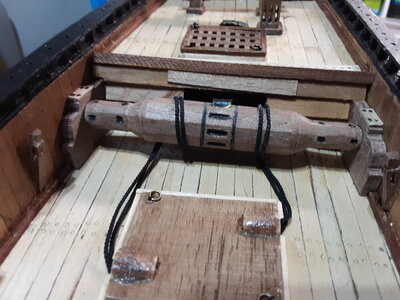
I will also add the square poles that fit into the square holes.
For a change of pace looked through the 2 mast and accessories plans en ID'd all the parts that make up the different masts. Using the measurements from the index of the book and the plans and multiplied it by 2 figured out the sizes of it all. My model is twice the size. Plans are 1:75 and model is 1:37.5. It is going to be a rather large model. I knew it was going to be big, but not "that" big. I'm not even going to think about when she is finished and where I am going to put her.
Marcus
After sanding the windlass barrel, added the ratchet teeth for the pawl bit. Painted the holes matt black. Added the supporting posts on each side and installed the complete piece on the upper deck. Added the anchor rope and put the excess into the holes of the hatch cover.


I will also add the square poles that fit into the square holes.
For a change of pace looked through the 2 mast and accessories plans en ID'd all the parts that make up the different masts. Using the measurements from the index of the book and the plans and multiplied it by 2 figured out the sizes of it all. My model is twice the size. Plans are 1:75 and model is 1:37.5. It is going to be a rather large model. I knew it was going to be big, but not "that" big. I'm not even going to think about when she is finished and where I am going to put her.
Marcus




